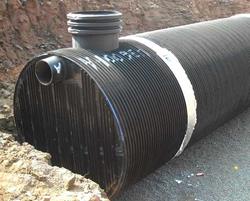Rainwater Harvesting and Make Up Water: The Why, When, and How

Rainwater harvesting (RWH) stores rainwater for reuse to supply non-potable uses like irrigation, wash water, toilet flushing, and laundry. During long dry periods the demand will drain the storage cistern down to a critical level where the pressurization pump(s) will need to shut down to prevent dry run damage. Make up water is typically a potable connection to the rainwater harvesting system to supply water, allowing the RWH system to continue to supply the non-potable end use applications until the next storm event refills the storage cistern.
There are two ways to connect make up water to RWH systems:
- Separation between the potable water and non-potable systems with a non-pressurized air gap. Water is supplied to the cistern to keep the minimum water level above the pump intakes to continue to operate without risk of a dry run condition that would damage the pumps.
- A pressurized connection between the potable to non-potable systems downstream of the RWH pump(s) to supply potable water to the non-potable end uses.
Make up water should be connected to the system in accordance with local plumbing codes. Some codes require an air gap connection between potable and non-potable systems. An air gap is essentially a non-pressurized connection from the potable to the non-potable systems allowing the supplied make up water to be at atmospheric pressure by dropping the makeup water “through the air” into the cistern storage. The RWH pumps would then re-pressurize the water from the cistern storage to the non-potable system. An automated 2-way valve is positioned on the potable supply leading to the harvested water cistern or day tank (depending on the design of the system).
When an air gap is not required, and a pressurized potable to non-potable connection is allowed by plumbing code, pressurized potable supply is used to supply the non-potable end uses. Typically a Reverse Pressure Zone (RPZ) valve is required on the potable supply side to prevent backflow contamination from the non-potable to potable systems. After the RPZ valve, an automated 3-way valve tee connection is used to pivot between the non-potable pump supplied water and the pressurized potable system make up water to provide the water to the non-potable end uses.
The valve that provides the makeup water is usually automated and would be controlled with either a float level switch or a tank level sensor and PLC controller to activate the valves upon user defined set points. With a 2-way valve connection to the storage cistern with an air gap, the levels in the storage cistern would be controlled to articulate the valve to only provide a minimal amount of potable make up water to allow the pressurization pumps to continue operating while allowing the majority of the storage cistern volume to be filled with harvested rainwater at the next storm event. So typically, the last 2” to 6” of elevation above the low level pump shut off elevation would be refilled with potable water allowing the non-potable pressurization pumps to continue to operate above their dry run elevation preventing damage to the pumps.
When a 3-way valve is used, the level sensor or float switch in the storage cistern will signal at a predetermined water elevation to articulate the valve to have potable water supplied, and the non-potable pressurization pumps would turn off above their low water shut down.
Not all RWH systems require make up water to be connected. Those that do not require make up water would be non-critical applications like irrigation or wash water applications that can either wait until the next storm event to refill the cistern volume or are not allowed to use make up water due to LEED accreditation. The other type of system that may not require makeup water would be a RWH system installed in parallel to an existing potable system that would enable the potable system to be used when the RWH system is not providing flow.
Source: Contech


